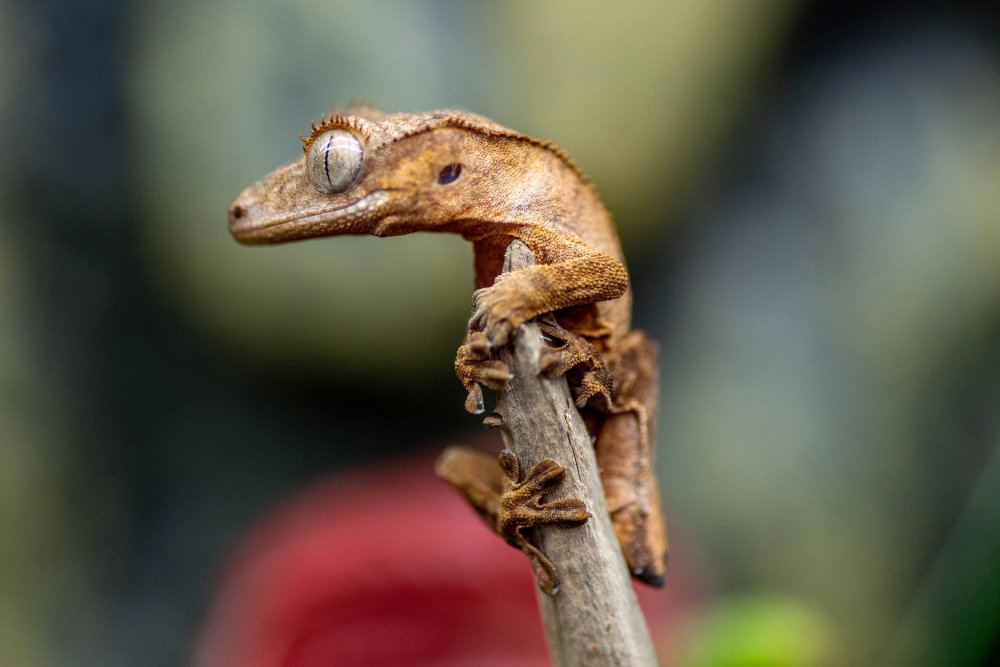Natural Habitat
Crested geckos are endemic to New Caledonia, a group of islands located in the southwest Pacific Ocean. They inhabit the southern portion of the main island, Grande Terre, and the Isle of Pines. These geckos thrive in the island’s rainforests and humid forests, where they live in the canopy and understory layers. The environment is characterized by high humidity and moderate temperatures, with abundant foliage that provides cover and hunting grounds for insects.
Physical Characteristics
Crested geckos are medium-sized geckos, typically reaching 8 to 10 inches in length, including their tail. They have a distinctive crest of spiny scales that runs from their eyes to their tails, giving them their common name. This crest resembles eyelashes, which adds to their unique appearance.
Their bodies are covered in smooth, velvety skin, which comes in a variety of colors and patterns, including shades of brown, red, orange, yellow, and grey. The patterns can be striped, spotted, or solid, and some individuals exhibit a harlequin pattern, which is highly sought after by breeders. Crested geckos have large, lidless eyes with vertical pupils, adapted for their nocturnal lifestyle. Their toes are equipped with tiny, hair-like structures called setae, which allow them to climb smooth surfaces with ease.
Behavior
Crested geckos are primarily nocturnal and arboreal, meaning they are most active at night and spend most of their time in trees. During the day, they hide in foliage or crevices to avoid predators and conserve moisture. At night, they emerge to hunt for food, which consists mainly of insects and fruit.
These geckos are known for their calm and docile temperament, making them popular pets. They are relatively easy to handle and rarely bite. When threatened, crested geckos may drop their tails in a process known as autotomy. Unlike some other gecko species, their tails do not regenerate, so this is a last resort defense mechanism.

Care Requirements
Caring for crested geckos is relatively straightforward, but it requires attention to detail to ensure they thrive in captivity. Here are the key aspects of their care:
A vertical enclosure is essential for crested geckos, as they are arboreal. A 20-gallon tank is the minimum size for one adult gecko, but larger enclosures are recommended for multiple geckos. The tank should be well-ventilated and include plenty of climbing structures, such as branches, vines, and plants. Live plants can help maintain humidity and provide natural hiding spots.
Temperature and Humidity
Crested geckos prefer temperatures between 72°F and 78°F during the day, with a slight drop at night. They do not require high heat, and temperatures above 82°F can be harmful. Humidity levels should be kept between 50% and 70%, with regular misting to maintain moisture. A hygrometer can help monitor humidity levels accurately.
Substrate
The substrate in the enclosure should retain moisture without becoming waterlogged. Options include coconut fiber, orchid bark, or a soil mixture. Paper towels can also be used for a more sterile environment, especially for juveniles or sick geckos.
Crested gecko is a omnivorous and has a diet that includes both insects and fruit. In captivity, a commercially prepared crested gecko diet (CGD) is recommended as the primary food source. This powdered diet is mixed with water to create a nutritious paste. In addition, they can be fed live insects such as crickets and dubia roaches, which should be dusted with calcium and vitamin supplements. Fresh fruit or fruit puree can be offered occasionally as a treat.
Providing fresh water is crucial. A shallow dish of clean water should be available at all times. Regular misting of the enclosure also helps maintain hydration, as geckos often lick water droplets from leaves and surfaces.
Handling and Socialization
Crested geckos are generally tolerant of handling, but it should be done gently and infrequently to avoid stress. Start by allowing the gecko to become accustomed to your presence before attempting to handle it. Once the gecko is comfortable, you can handle it for short periods, always supporting its body to prevent falls.
Crested Geckos in the Pet Trade
Crested gecko was thought to be extinct until their rediscovery in 1994. Since then, they have become popular pets due to their striking appearance, manageable care requirements, and docile nature. They are widely bred in captivity, reducing the need for wild-caught individuals and helping to conserve their natural populations.
Conservation Status
The IUCN Red List classifies crested geckos as vulnerable, primarily due to habitat loss and degradation in their native range. Conservation efforts focus on habitat preservation and captive breeding programs to ensure the species’ survival. Responsible pet ownership and breeding practices are essential to maintain healthy populations both in the wild and in captivity.
Conclusion
Crested geckos are fascinating reptiles that make excellent pets for both novice and experienced reptile keepers. Their unique appearance, easy-going nature, and relatively simple care requirements contribute to their popularity. By providing proper housing, diet, and care, crested gecko owners can enjoy the companionship of these remarkable creatures while contributing to their conservation.









